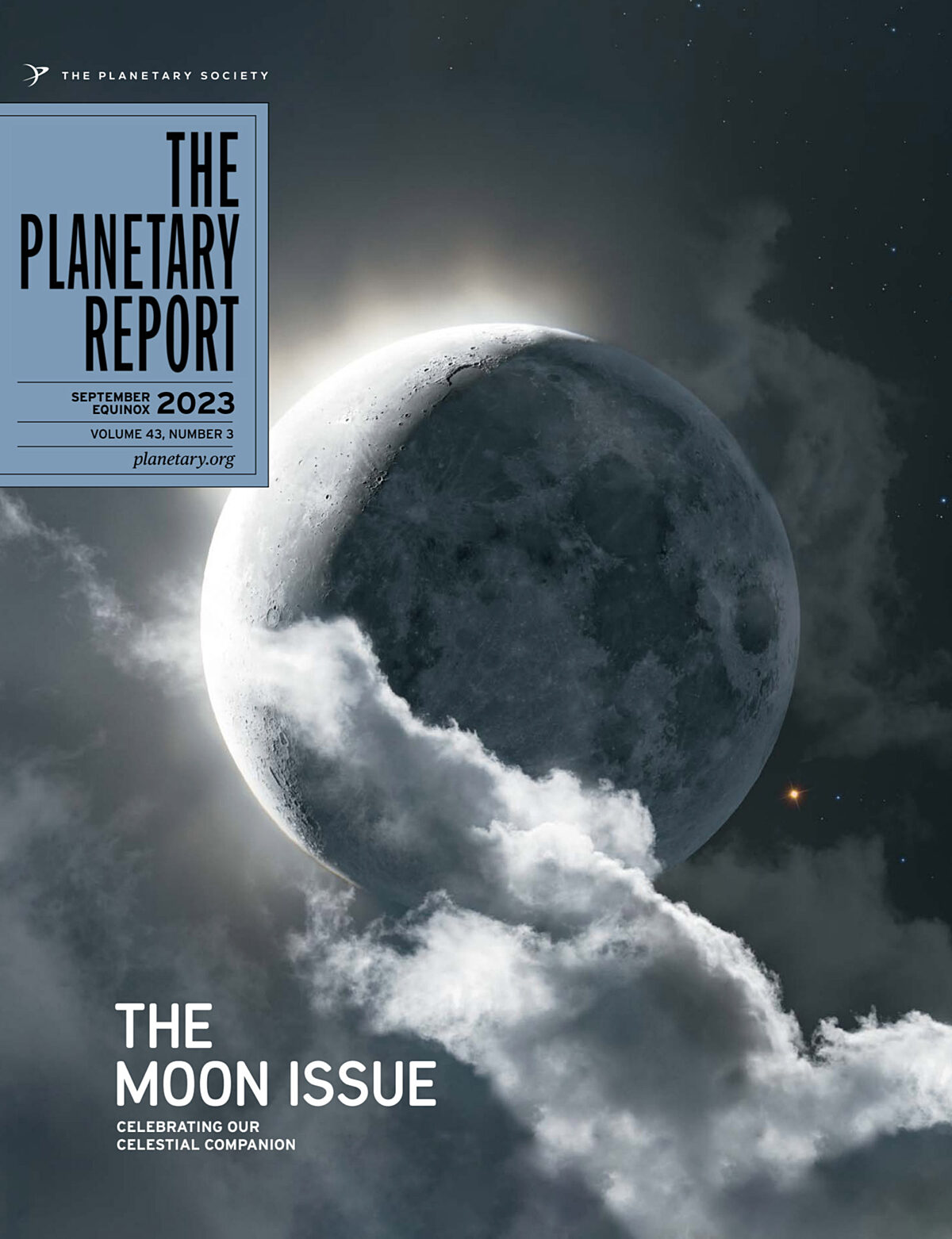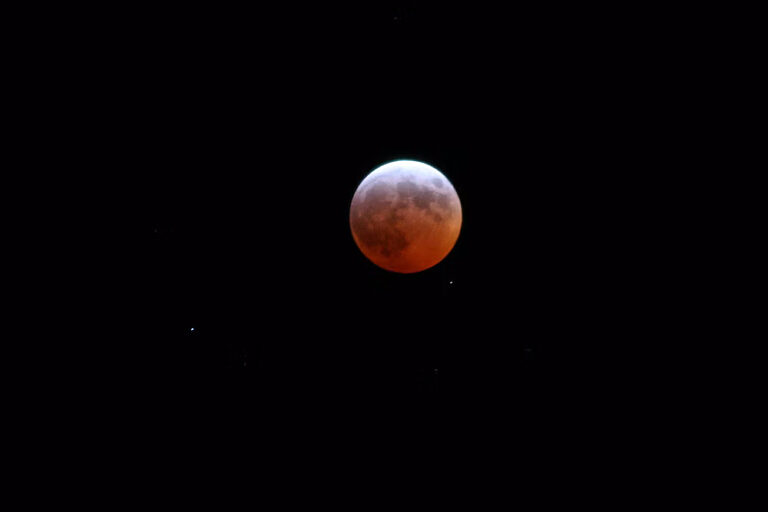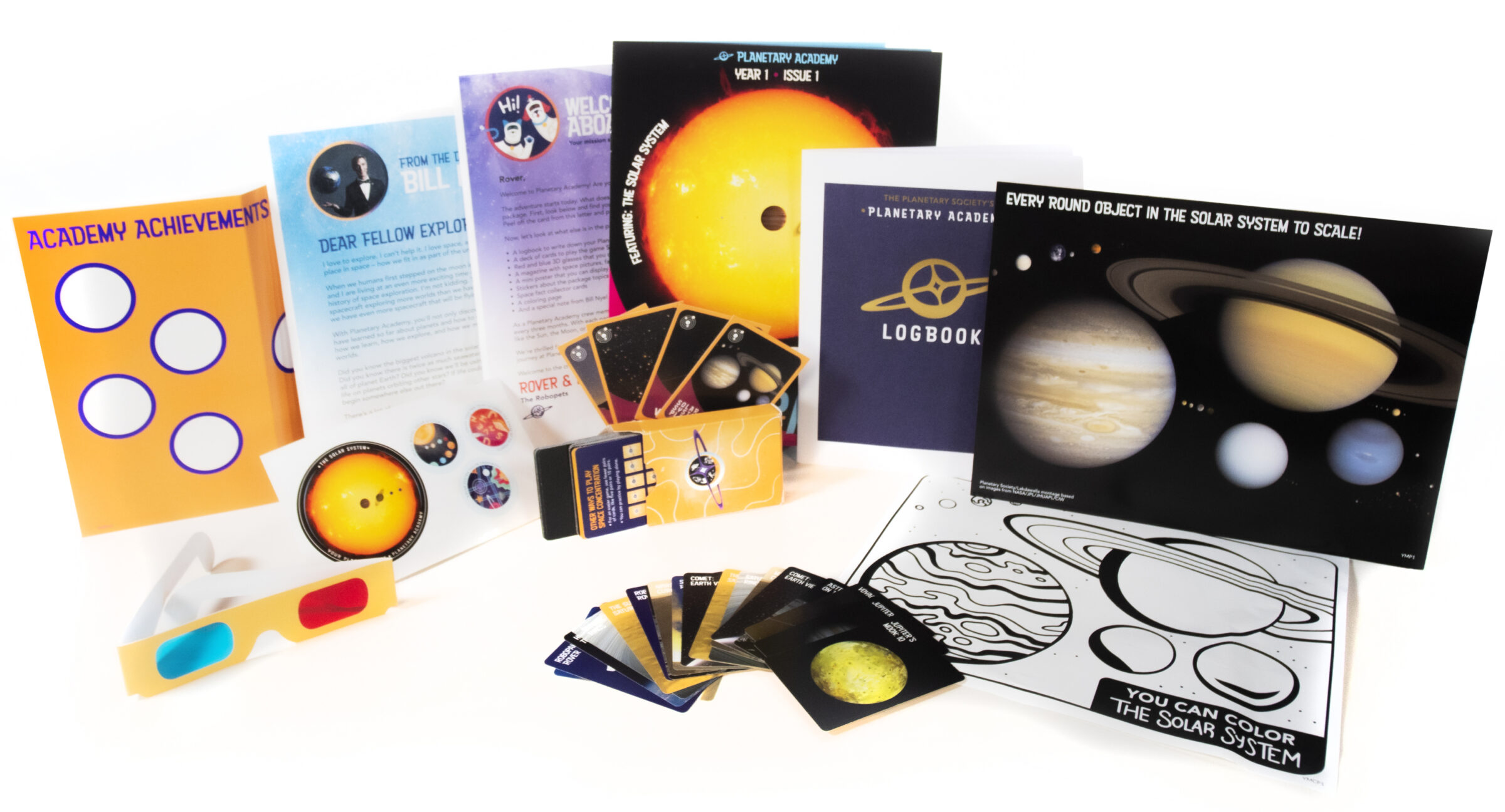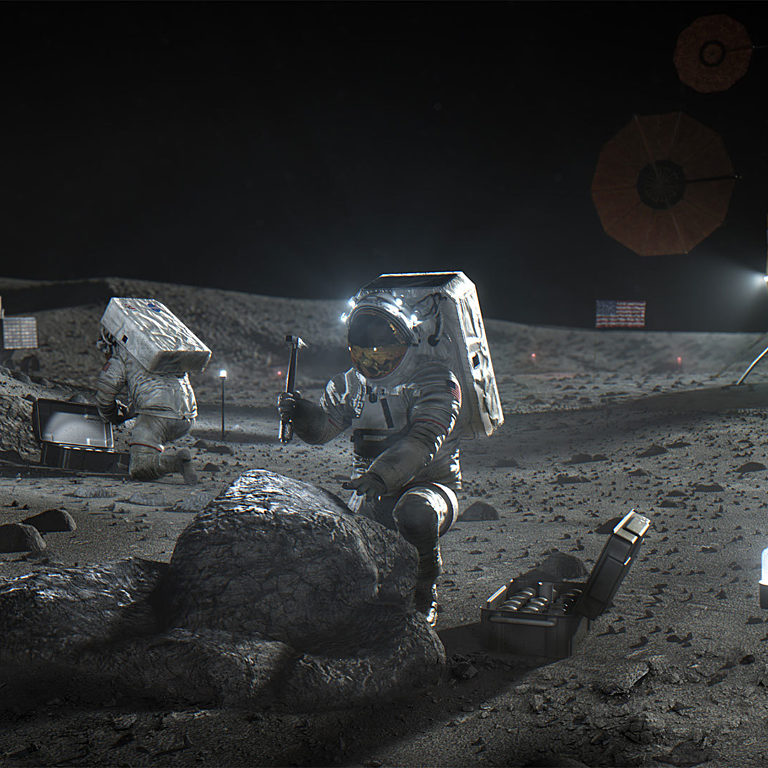
On the Cover: This gorgeous image captured by astrophotographer Andrew McCarthy in early 2020 shows the Moon shrouded by clouds while simultaneously occulting Mars, reminding us of our Earthly connection to our only satellite and its role in the future human exploration of our Solar System.
Download PDF
Features
September Equinox 2023
Moonstruck
Exploring humanity’s long relationship with the Moon.
A lunar saga
How the origins of the Moon could shape the future of human space exploration.
To the moon together
An interview with Scott Pace about the Moon’s role in internationally cooperative human space exploration.
Your impact: September equinox 2023
Meet the asteroid hunters you help support.
Your place in space
A moon worthy of waxing poetic
By Bill Nye, Planetary Society CEO
Welcome to the lunar issue. Earth’s Moon — the Moon, as we call it — has a special place in our sky and in our hearts. Its size and position in space produce remarkable effects here on Earth. First, as ancient biblical authors wrote, it’s as though we have two sources of light to find our way: the Sun by day and the Moon by about half of our nights. Then, the Moon’s gravity provides about half the tractive force that raises ocean tides, which in turn create entire ecosystems. When conditions are right, the Moon blocks or subtends (what a word!) about half a degree of arc, almost exactly the same width and breadth of sky as our closest star: our Sun. In the next few months, the Moon will produce two dramatic solar eclipses in North America. Because they’ll be accessible by all sorts of roads and highways, I encourage everyone in this part of the world to make travel plans to be in the shadows. There’s nothing quite like it. We’ll have plenty of information about these events in this issue and in upcoming issues.
Along with the physical influence of the Moon’s gravity and reflected light, its cultural influence is amazing. Ancient Greek observers noticed that when Earth’s shadow falls on the Moon, it’s always curved. The only object conceivable that casts a curve in any orientation is a sphere. Therefore, they realized that Earth is round. By inference, so is the Moon. Even without a telescope, you can see the Moon’s round shape and topography. With a telescope or binoculars, one easily discovers the craters — thousands of them — pockmarking its surface.

The Moon has also made us a spacefaring species. It’s as though
nature provided our species with an ideal jumping-forth place to explore
the Cosmos. It is always up there beckoning. As humankind took flight,
the Moon became the obvious destination beyond the sky. With an enormous
investment, humans walked on its surface. And indeed, new crews will be
back there in just a few years. Just think about what they’ll discover.
Speaking of discovering things, the Moon is inspiring, and so we chose
it as one of the first topics shared in our new kids’ program, Planetary
Academy.
And speaking of news of new crews, as you read this issue, you’ll see that the Moon has also become the perfect place for international cooperation in space. You’ll hear from one of the world’s leading experts in space policy about why that has come to be. You’ll also see astonishing photos that members like you have taken of our Moon, all of which were shared in your online member community. This virtual meeting place for members has been up and running since March; I continue to be amazed by the quality of discussion, the wonderful events, and the passion that our members have for space science and exploration. Every three lunar orbits or so (every quarter), I present this column. I often go on about how none of what we do here at the Society to engage members, inspire kids and families, and influence the space policies of governments around the world would be possible without you. It’s absolutely true. So, thank you. And now, to the Moon!
Members on deck
Member moon shots
In our online member community, we invited Planetary Society members to share photos taken of the Moon, and you came through! These are some of our favorite Moon shots taken by members. You can find more at community.planetary.org in the “Look Up!” space.





Get involved
Go see the annular solar eclipse!
On Saturday, Oct. 14, 2023, a spectacular annular solar eclipse will cross North, Central, and South America. It will be visible in parts of the United States, Mexico, and many countries in South and Central America.
An annular eclipse occurs when the Moon appears slightly smaller than the Sun and cannot cover the Sun completely. This leaves an annulus, or circle, of Sun still visible on the outside of the Moon. This is sometimes called the “ring of fire.”
Never look directly at the Sun during an annular eclipse. The Sun is never completely blocked by the Moon during an annular solar eclipse. Therefore, during an annular eclipse, it is never safe to look directly at the Sun without specialized eye protection designed for solar viewing.
The annular solar eclipse begins in Oregon at 9:13 a.m. PDT and ends in Brazil at 5:13 p.m. CST.
Save the date: Eclipse-O-Rama 2024
The last total solar eclipse in North America for 20 years takes place on April 8, 2024. Mark your calendar for a celestial celebration designed especially for Planetary Society members. Eclipse-O-Rama 2024 will take place in Fredericksburg, Texas, from April 7-8, with live music, educational talks, and engaging activities for all ages. Our CEO, Bill Nye the Science Guy, will be there to share his passion for all things space. Bring your camping gear to stay with us under the stars or book a room in one of our hotel blocks for two unforgettable days of science, discovery, and fun. For updates, visit planetary.org/eclipseorama2024.
NASA's first asteroid sample will arrive soon
On Sept. 24, 2023, Earth will receive the ultimate space souvenir: a sample from the near-Earth asteroid Bennu, delivered by NASA’s OSIRIS-REx (Origins, Spectral Interpretation, Resource Identification, Security-Regolith Explorer). We’re planning to watch the return and celebrate with Planetary Society members near the drop-off location in Salt Lake City, Utah. Even if you can’t join us, it will be worth tuning into the NASA livestream to watch the nail-biting delivery — the spacecraft must approach Earth at a precise speed and direction to safely deliver its sample return capsule into Earth’s atmosphere. Learn more at planetary.org/osirisrex.
It’s almost International Observe the Moon Night!
On Oct. 21, Moon enthusiasts and curious individuals will unite to learn about lunar science and exploration, take part in celestial observations, and honor personal and cultural connections to the Moon. You can participate in International Observe the Moon Night from anywhere. Join virtual or in-person events, observe from home, and engage with fellow enthusiasts through social media platforms using #ObserveTheMoon. Learn more at moon.nasa.gov/observe-the-moon-night.
Enhance your young explorer’s return to school
If you know a kid who’s fascinated by the Cosmos, now’s the perfect time to sign them up for Planetary Academy, a Planetary Society membership designed exclusively for kids ages 5 to 9. Members receive an educational adventure pack every three months that is developed by our space science experts and filled with stunning images, fascinating facts, hands-on activities, experiments, games, and unexpected delights. Your young explorer will be transported to a new world every three months, giving them a full tour of our Solar System. Sign them up today for $99 a year with an option to renew annually. Go to planetary.org/planetary-academy.
Planetary academy is endorsed by leading educational minds
“Through my roles on ‘Star Trek’ and ‘Reading Rainbow,’ I have seen generations of curious minds inspired by the strange new worlds explored in books and [on] television. I know how important it is to encourage that curiosity in a young explorer’s life. That’s why I am excited to share with you a new program from my friends at The Planetary Society. It’s called Planetary Academy, and anyone can join. A lifelong passion for space, science, and discovery starts when we’re young. Give the gift of the Cosmos to the explorer in your life.” — LeVar Burton, Planetary Society Supporter

Calendar of events
September
18
The Planetary Society’s Day of Action (Washington, D.C.)
23
Fall/spring equinox
24
OSIRIS-REx returns sample of Bennu to Earth
October
2–6
International Astronautical Congress (Baku, Azerbaijan)
4–10
World Space Week
5
NASA’s Psyche mission launch window opens
14
Annular solar eclipse (North America)
21
International Observe the Moon Night
21–22
Orionids meteor shower
28
Partial lunar eclipse (Europe, Asia, Africa, and western Australia)
November
17–18
Leonids meteor shower
30
Manhattanhenge
December
13
Geminid meteor shower
What's up?
Annular eclipse and a most excellent meteor shower

By Bruce Betts, Planetary Society Chief Scientist
In the sky
Super-bright Venus is in the predawn east, dropping lower to the horizon as the weeks pass. Very bright Jupiter and yellowish Saturn are in the eastern evening sky. They move westward as the weeks pass. There is an annular solar eclipse on Oct. 14. Those on the path of annularity (find more information on page 19) will see an annulus (ring) of the Sun surrounding the Moon, and much of the rest of North and South America will see a partial solar eclipse. Use proper eye protection! On Oct. 28, there is a partial lunar eclipse visible from Europe, Africa, Asia, and Australia, but only a small portion of the Moon enters the dark umbral part of Earth’s shadow. The Geminids meteor shower peaks Dec. 13/14 with increased activity several days before and after. The Geminids is usually the best shower of the year with 100+ meteors per hour from a dark site, and this year, there will be little interference from a crescent Moon. For more night sky tips, you can always check out planetary.org/night-sky.
Random space fact
Having essentially no atmosphere to protect it, the Moon’s surface darkens with age over long periods of time due to space weathering, including interactions with the solar wind. This darkening is the main reason material thrown out by younger craters appears brighter than the surroundings.
Trivia contest
Our March equinox contest winner is Chris Mills of Arlington, Virginia, USA. Congratulations! The question was: Other than on Earth, where in the Solar System is there a feature named Thor? The answer: On Jupiter’s moon Io. Thor is a volcano.
Try to win a copy of the new book “Solar System Reference for Teens” by Bruce Betts and a Planetary Radio T-shirt by answering this question: In our Solar System, how many moons are larger than Earth’s Moon?
Email your answer to [email protected] or mail your answer to The Planetary Report, 60 S. Los Robles Ave., Pasadena, CA 91101. Make sure you include the answer and your name, mailing address, and email address (if you have one). By entering this contest, you are authorizing The Planetary Report to publish your name and hometown. Submissions must be received by December 1, 2023. One entry per person. The winner will be chosen in a random drawing from among all the correct entries received.
Astronomical art
The book of Moon
It’s a tradition among many grad students to burn a copy of their Ph.D. thesis after successfully defending it. When planetary scientist and artist Jamie Molaro finished her Ph.D. at the University of Arizona, she opted for a different form of catharsis. “My thesis focused on how rocks weather and break down on the Moon, so from the pages, I carved a cratered lunar landscape,” said Molaro. She used data from the Lunar Orbiter Laser Altimeter aboard NASA’s Lunar Reconnaissance Orbiter to carve accurate, detailed lunar topography into her thesis, page by page. “It juxtaposes the science behind the breakdown process with the beauty of the landscape it helps to produce. You can also see the text and figures on the pages peek through the topography. So, the pages of the thesis also reveal the scientific process, juxtaposing the creation of knowledge with the creation of art.”
Do you want to see your artwork here? We love to feature our members throughout this magazine. Send your original, space-related artwork to [email protected].
The Planetary Report • September Equinox 2023
Help advance space science and exploration! Become a member of The Planetary Society and you'll receive the full PDF and print versions of The Planetary Report.


 Explore Worlds
Explore Worlds Find Life
Find Life Defend Earth
Defend Earth






